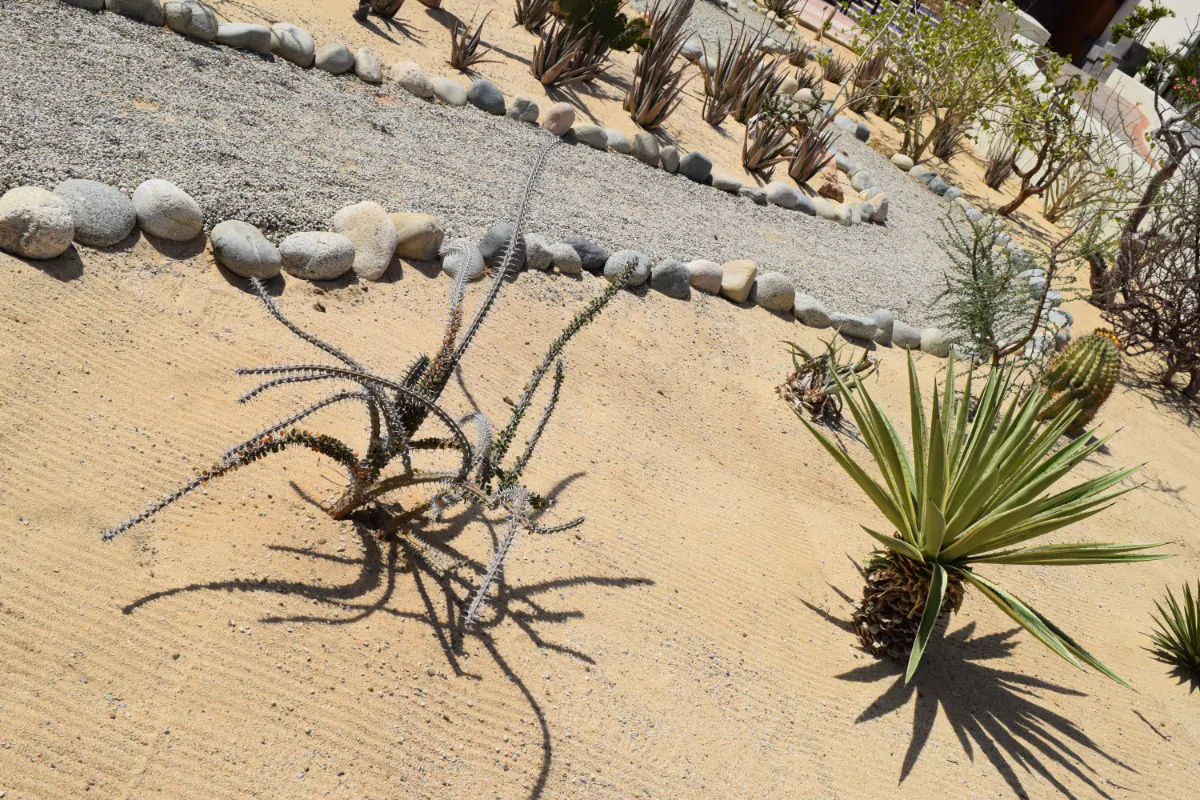Landscaping is a fun hobby to have for homeowners, but we must admit, it’s not simply about planting pretty flowers and arranging rocks. Especially in desert regions, where harsh conditions challenge even the most seasoned gardeners, creating a thriving outdoor oasis requires consideration and planning. That’s where the beauty of low-maintenance desert landscape plants comes into play.

In this guide, we’ll explore the top 7 plants perfectly suited for desert environments, each chosen for its resilience, adaptability, and striking aesthetic appeal. Whether you’re a gardening enthusiast seeking to enhance your outdoor space or a novice starting a sustainable landscaping design and installation journey, this article is your roadmap to success.
Agave

Agave plants are succulents with large, spiky leaves that store water. They are native to the arid and semi-arid regions of the Americas, particularly Mexico, and the Caribbean. There are over 200 species of agave, and they come in a variety of shapes and sizes, from small, compact plants to large, towering specimens.
Moreover, agave plants are popular ornamental plants, and they can be used to add a touch of desert beauty to any landscape. The blue agave plant (Agave tequilana) is used to produce tequila. Other agave species are used to produce mescal.
Care Tips
Agave plants are prized for their low-maintenance nature, making them perfect additions to any desert landscape. Here’s how to make sure your agave thrives in its new environment:
- Sun it up: Agave thrives in full sun, ideally at least 6 hours a day. They love the warmth that mimics their desert origins.
- Drainage is key: Agave despise soggy feet. Opt for a pot with drainage holes and a well-draining succulent or cactus mix.
- Water wisely: Water deeply but infrequently, allowing the soil to dry out completely between waterings. Overwatering is a major killer of agaves.
- Know when to repot: Repot young agaves every year or two in a slightly larger pot with fresh, well-draining mix. Mature agaves can stay in their container for many years if drainage remains good.
Benefits of Using Agave in Desert Landscapes
Incorporating agave into your desert landscape offers numerous benefits beyond its aesthetic appeal. Here are some reasons why agave is one of the best desert landscape plants:
- Drought Tolerance: Agaves are incredibly drought-tolerant, making them perfect for water-wise landscaping in arid regions.
- Low Maintenance: Once established, agave plants require minimal care, saving you time and effort in maintaining your landscape.
- Erosion Control: The dense rosettes of agave plants help prevent soil erosion, making them valuable additions to slopes and hillsides.
Incorporating agave into your desert landscape not only enhances its beauty but also contributes to its sustainability and resilience in the face of challenging environmental conditions.
Yucca
Sure, yucca is a genus of over 40 perennial plants, shrubs, and trees, native to the Americas and the Caribbean. They are known for their rosettes of evergreen, tough, sword-shaped leaves, and large branched flower clusters of white or whitish flowers.
There are two main types of yucca plants: those grown outdoors and those grown indoors as houseplants. Outdoor yucca plants are native to the Southwest U.S. They prefer dry, sandy regions like the desert and Great Plains. They can tolerate poor, sandy, well-drained soils in full sun, efficiently handling heat, drought, and salt spray.

On the other hand, the most common indoor yucca plants are Yucca gigantea, also known as Y. guatemalensis and Y. elephantipes, which are prized for their architectural form, resilience, and ability to thrive in low-light conditions
Care Tips
Yucca plants are renowned for their low maintenance, making them ideal choices for Low-Maintenance Desert Landscape Plants. Here’s how to make sure your yucca thrives in its new environment:
- Bright Indirect Light: Yucca plants love sunshine, but not the harsh kind. Aim for a spot in your house that gets plenty of bright, indirect sunlight. Think close to a south-facing window where the sun won’t directly hit the leaves all day.
- Potting Mix Matters: A well-draining potting mix is essential. A cactus or succulent mix will work well, or you can create your own by mixing regular potting soil with sand or perlite for extra drainage.
- Less is More on Fertilizer: Yucca plants are not heavy feeders. A light feeding once or twice a year during the growing season (spring and summer) is plenty.
Benefits of Using Yucca in Desert Landscapes
Incorporating yucca into your landscape maintenance offers numerous benefits, making it one of the best low-maintenance desert plants available. Yucca is an excellent choice for desert landscaping because:
- Natural Erosion Control: Yucca’s roots help anchors the soil and prevent erosion from wind and heavy rains, which are common occurrences in deserts. This helps maintain the health of the desert ecosystem.
- Wildlife Habitat and Food Source: Yucca plants are not just beautiful; they’re also beneficial to desert wildlife. Many desert bird species find shelter and nesting sites amongst the yucca’s branches.
- Low-Maintenance Beauty: This makes them perfect for desert landscapes where water conservation is crucial. Their form and foliage add a touch of beauty and texture to the landscape without demanding constant attention.
Cacti
Cacti are succulents, meaning they have thick, fleshy stems that store water. This is essential for survival in hot, dry climates where water is scarce. Cacti also have a special waxy coating on their stems that helps to reduce water loss through evaporation

One of the most recognizable features of cacti is their spines. These spines come in all shapes and sizes, and they serve many purposes. Spines help to protect cacti from herbivores, who might otherwise eat the water-storing stems. They also help to shade the cactus from the sun, further reducing water loss.
Care Tips
Despite their prickly exterior, cacti can be surprisingly beautiful plants. Here are some care tips to keep in mind:
- Sun Soaking – Cacti crave sunshine! Place them in a south or west-facing window for maximum natural light exposure. During summers, you can bring them outdoors for a dose of direct sunlight, but be mindful of sunburn. If natural light is limited, consider using grow lights to supplement.
- Water Wisely – While they store water, cacti still need watering, but not too often! The key is to water deeply and then allow the soil to dry out completely before watering again. Overwatering is a major killer for cacti, so err on the side of underwatering. During winter months, when they’re dormant, water even less frequently.
- Drainage is Crucial – Cacti despise soggy roots. Ensure your cactus pot has drainage holes at the bottom. Use a well-draining cactus mix that includes sand, perlite, or other coarse materials to promote drainage and prevent root rot.
Benefits of Using Cacti in Desert Landscapes
Cacti anchor desert ecosystems, offering a habitat for diverse fauna, soil stabilization, and vital water absorption, key to arid environment.
- Water Warriors: Cacti are champions of water conservation. Their adaptations like water-storing stems and waxy coatings minimize water loss, making them perfect for arid environments.
- Wildlife Oasis: Despite their prickly exterior, cacti provide a valuable food and water source for desert wildlife. The sweet nectar of their flowers attracts pollinators like bats and hummingbirds, while the juicy fruits provide a vital water source for birds and small mammals.
- Low Maintenance Marvels: Cacti are the low-maintenance champions of the plant world. Once established, they require minimal care.
Aloe Vera
Aloe vera is a succulent plant species that has been cultivated for centuries for its medicinal properties. Originally from the Arabian Peninsula, aloe vera is now widely distributed around the world, thriving in tropical, subtropical, and arid climates. It’s an evergreen perennial with thick, fleshy leaves that grow in a rosette shape. The leaves have a gel-like interior that stores water, which is the part used for medicinal purposes.

Aloe vera is most known for its soothing properties when applied to sunburns. However, research suggests it may also be helpful for a variety of other conditions.
Care Tips
Aloe vera is a relatively low-maintenance plant. Here are some tips for keeping your aloe vera healthy:
- Sunlight: Provide bright, indirect sunlight. If you don’t have enough natural light, consider supplementing with grow lights during the winter months.
- Watering: Water deeply but infrequently, allowing the soil to dry out completely between waterings. A good rule of thumb is to stick your finger into the soil. If the top inch or two feels dry, it’s time to water.
- Drainage: Use a well-draining potting mix. Terracotta pots are a good choice for aloe vera because they allow for better airflow and drainage than glazed ceramic pots.
- Potting: Repot your aloe vera every 2-3 years, or when it becomes rootbound. The pot should be just slightly larger than the root ball.
Benefits of Using Aloe Vera in Desert Landscapes
Aloe vera offers several unique benefits for desert landscapes, going beyond its typical household uses.
- Water Conservation Champion: The thick, fleshy leaves act like reservoirs, allowing the plant to survive on infrequent watering.
- Microclimate Creation: Beyond water conservation, aloe vera can help create a more favorable microclimate around it. Through transpiration (releasing water vapor through leaves), aloe vera contributes to localized humidity.
- Wildlife Food Source: While not the most appealing food source, aloe vera flowers and young pups (baby aloe vera plants) can be a valuable food resource for desert wildlife, particularly during dry periods when other food sources are scarce
Desert Marigold
The Desert Marigold, also known as Baileya multiradiata, is a beautiful and low-maintenance wildflower native to the deserts of northern Mexico and the Southwestern United States. It’s a member of the Asteraceae family, which includes daisies, sunflowers, and asters.

Desert marigold is a small perennial with a low, spreading habit. It typically grows 12-18 inches tall and 24-30 inches wide. The leaves are silvery gray-green and lobed, covered in fine hairs. The star of the show is the bright yellow, daisy-like flowers that bloom on tall stems from late winter and intermittently throughout summer.
Care Tips
Once established, desert marigolds are pretty low maintenance. The care tips below will make the lifespan of the plant longer:
- Mimic the Desert: Desert marigolds thrive on neglect when it comes to watering. Water deeply every 3 weeks, allowing the soil to dry completely in between. Overwatering is more harmful than underwatering for this desert native.
- Sun Worship: Plant your desert marigolds in a location that gets at least 6-8 hours of direct sunlight each day. This will encourage abundant blooms and keep the plants compact.
- Deadhead for More Blooms: To extend the flowering season, deadhead spent blooms by pinching them off just below the flower head. This will encourage the plant to put out new flowers instead of setting seed.
Benefits of Desert Marigolds in Desert Landscapes
Desert marigolds are not only beautiful additions to rock gardens and wildflower meadows but can also bring other benefits like:
- Superior Drought Tolerance: Unlike many flowering plants, desert marigolds shine in the harsh conditions of arid climates. Their silvery leaves minimize water loss through reflection, and their deep root systems tap into moisture reserves deep underground. This exceptional drought tolerance makes them perfect for water-wise landscapes and xeriscaping projects.
- Natural Pest Repellent: Desert marigolds possess compounds called thiophenes, which have a pungent odor that deters some insects like nematodes, aphids, and whiteflies. Interplanting them with your vegetables can create a natural barrier against these common garden pests.
- Self-Seeding Marvels: Desert marigolds are champions at self-seeding. Once established, they readily drop their seeds after flowering. These seeds lie dormant in the soil until the next season’s rains, ensuring a beautiful display of blooms year after year with minimal effort on your part.
Desert Willow
The Desert Willow (Chilopsis linearis) is a beautiful flowering tree or shrub native to the southwestern United States and northern Mexico. It’s a popular ornamental plant prized for its showy blooms, drought tolerance, and easy maintenance.
While called a willow, it’s not a true willow. It belongs to the catalpa family, which also includes Yellowbells (Tecoma stans) and Trumpet vine (Campsis radicans). They get their common name from their long, narrow leaves that resemble those of a willow tree.

Care Tips
Desert Willows are very adaptable and can tolerate a wide range of soils. Here are some additional tips for growing desert willows:
- Watering: Desert willows are drought-tolerant champions, but that doesn’t mean they never need a drink. In the winter, reduce watering to once a month, or even less depending on your rainfall.
- Sun and Soil: Desert willows crave sunshine, so pick the brightest spot in your garden. At least 6-8 hours of direct sunlight is ideal. Amend your soil with sand or gravel if necessary to ensure water doesn’t pool around the roots.
- Pruning for Beauty and Blooms: While desert willows are naturally low-maintenance, pruning can enhance their beauty and flowering. The best time to prune is in late winter or early spring before new growth appears.
Benefits of Using Desert Willow in Desert Landscapes
If you choose to use desert willows for your landscapes, here are some benefits you may notice:
- Water Wise Wonder: Once established, they thrive on infrequent deep waterings, translating to less time spent watering and less money on your water bill.
- Blooming Beacon for Pollinators: Desert willows explode with color throughout the summer, bringing vibrancy and life to the barren desert landscape.
- Fast Facts, Slow Growth: Desert willows’ fast initial growth helps them establish quickly, providing wind resistance and much-needed shade for themselves and other nearby plants.
Palo Verde
Palo verde trees are a beautiful, iconic part of the Sonoran Desert landscape. Their name comes from the Spanish word for “green stick,” which perfectly describes their smooth green bark. There are about 12 species of palo verde, all native to arid regions of the southwestern United States, Mexico, Central America, and Venezuela.

There are different kinds of palo verde plants. Blue palo verde (Parkinsonia florida) is the most popular variety for landscaping. It has blue-green bark and fragrant yellow flowers. Foothill palo verde (Parkinsonia microphylla) is a smaller variety, typically growing to 15-20 feet tall. It has yellow flowers and feathery green leaves.
Care Tips
When caring for palo verde plants, keep these in mind:
- Sun and Drainage: Palo verde trees thrive in full sun, mimicking their desert habitat. When planting, choose a location that gets plenty of sunlight throughout the day. Equally important is well-draining soil.
- Watering Wisely: Even though palo verde is drought-tolerant, young trees need regular watering to establish a healthy root system. Deep soak the surrounding soil every couple of weeks during the summer and once a month in other seasons for the first year or two.
- Strategic Pruning (Optional): While not essential, you can prune your palo verde to maintain its shape or raise the canopy. Prune during warm weather while the tree is actively growing.
Benefits of Palo Verde in Desert Landscapes
Aside from producing bright yellow flowers in the spring, palo verde offers even more:
- Nitrogen Fixation: Palo verde trees can fix nitrogen from the air. This means they have a symbiotic relationship with certain bacteria in their roots that convert atmospheric nitrogen into a form usable by the tree and other plants in the surrounding soil.
- Nurse Plant: Palo verde trees act as “nurse plants” for other desert flora, particularly slow-growing cacti like saguaros. The palo verde’s canopy provides essential shade and protection from the harsh desert sun for young cacti, allowing them to establish themselves before needing to fully tolerate the intense heat.
- Wildlife Habitat and Food Source: Palo verde trees provide vital habitat and food for a variety of desert wildlife. The dense foliage offers nesting and hiding spots for birds, while small mammals find shelter from the heat underneath the cool shade.
You may be interested in this article: Three Most Common Trees Native to New Mexico
Conclusion
Now that we’ve covered seven of the lowest maintenance plants for desert landscapes, creating a stunning desert landscape doesn’t have to be a daunting task for you!
With their resilience, beauty, and sustainability, these desert landscape plants offer the perfect solution for homeowners looking to enhance their outdoor spaces while minimizing maintenance efforts.
So, roll up your sleeves, dig in the dirt, and let the beauty of the desert inspire your landscape design journey. Your oasis awaits!






